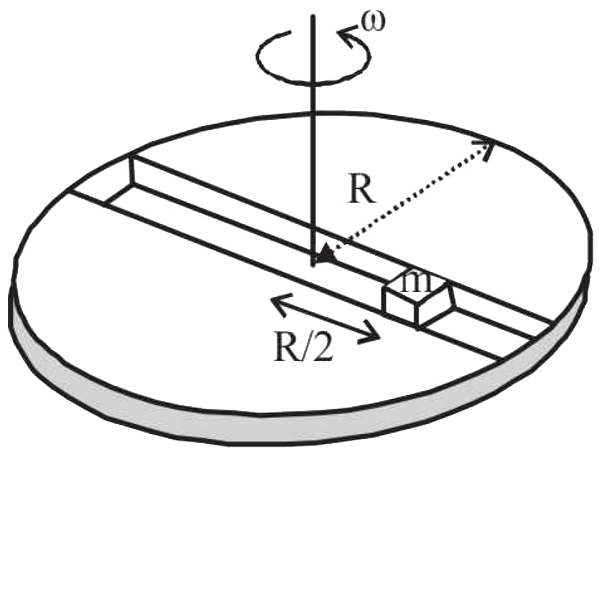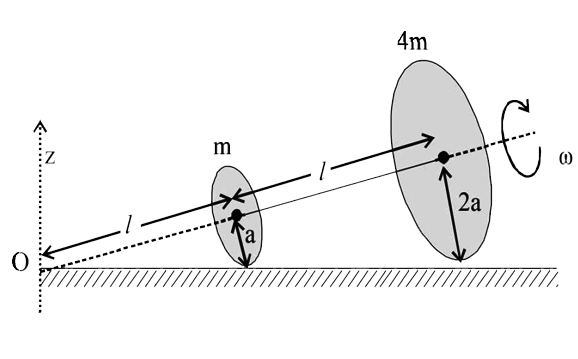The electrostatic energy of Z protons uniformly distributed throughout a spherical nucleus of radius R is given by
E=3Z(Z−1)e25(4πe0R)
The measured masses of the neutron _(1)1H,157Nand,168Oare1.008665u,1.007825u,15.000109uand15.003065u, respectively Given that the ratio of both the _(7)12N and _(8)15O nucleus are same , 1 u = = 931.5 Me Vc2 (c is the speed of light ) and e2/(4πe0)=1.44MeV fm Assuming that the difference between the binding energies of _715Nand_(8)^(15) O is purely due to the electric energy , The radius of the nucleus of the nuclei is
Step by step video & image solution for The electrostatic energy of Z protons uniformly distributed throughout a spherical nucleus of radius R is given by E = (3 Z(Z- 1)e^(2))/5( 4 pi e _(0)R) The measured masses of the neutron _(1)^(1) H, _(7)^(15) N and , _(8)^(16)O are 1.008665 u, 1.007825 u , 15.000109 u and 15.003065 u, respectively Given that the ratio of both the _(7)^(12) N and _(8)^(15) O nucleus are same , 1 u = = 931.5 Me Vc^(2) (c is the speed of light ) and e^(2)//(4 pi e_(0)) = 1.44 MeV fm Assuming that the difference between the binding energies of _7^(15) N and _(8)^(15) O is purely due to the electric energy , The radius of the nucleus of the nuclei is by Physics experts to help you in doubts & scoring excellent marks in Class 12 exams.
Updated on:21/07/2023Topper's Solved these Questions
- JEE ADVANCEDBOOK - JEE ADVANCED PREVIOUS YEARCHAPTER - JEE ADVANCEDEXERCISE - PART I : PHYSICS (SECTION 3)
2 Videos
- JEE ADVANCEDBOOK - JEE ADVANCED PREVIOUS YEARCHAPTER - JEE ADVANCEDEXERCISE - Part I : PHYSICS (Section 2)
13 Videos
- JEE ADVANCEDBOOK - JEE ADVANCED PREVIOUS YEARCHAPTER - JEE ADVANCEDEXERCISE - PART-1 PHYSICS (SECTION 3 )
5 Videos
- JEE (ADVANCE) 2020BOOK - JEE ADVANCED PREVIOUS YEARCHAPTER - JEE (ADVANCE) 2020EXERCISE - SECTION 3
6 Videos
- JEE ADVANCED 2020BOOK - JEE ADVANCED PREVIOUS YEARCHAPTER - JEE ADVANCED 2020EXERCISE - SECTION-3
6 Videos
Similar Questions
A frame of reference that is accelerated with respect to an inertial frame of reference is called a non-inertial frame of reference. A coordinate system fixed on a circular disc rotating about a fixed axis with a constant angular velocity ω is an example of non=inertial frame of reference. The relationship between the force →Frot experienced by a particle of mass m moving on the rotating disc and the force →F∈ experienced by the particle in an inertial frame of reference is
→Frot=→Fin+2m(→vrot×→ω)+m(→ω×→r)×→ω.
where →vrot is the velocity of the particle in the rotating frame of reference and →r is the position vector of the particle with respect to the centre of the disc.
Now consider a smooth slot along a diameter fo a disc of radius R rotating counter-clockwise with a constant angular speed ω about its vertical axis through its center. We assign a coordinate system with the origin at the center of the disc, the x-axis along the slot, the y-axis perpendicular to the slot and the z-axis along the rotation axis (→ω=ωˆk). A small block of mass m is gently placed in the slot at →r(R/2)ˆi at t=0 and is constrained to move only along the slot.

The distance r of the block at time is
View SolutionTwo thin circular discs of mass m and 4m, having radii of a and 2a, respectively, are rigidly fixed by a massless, rigid rod of length l=√24a through their centres. This assembly is laid on a firm and flat surface, and set rolling without slipping on the surface so that the angular speed about the axis of the rod is ω. The angular momemtum of the entire assembly about the point 'O' is vacL (see the figure). Which of the follwing statement (s) is (are) true?

View SolutionA metal is heated in a furnace where a sensor is kept above the metal surface to read the power radiated (P) by the metal. The sensor has scale that displays log2,(P/P0), where P0 is constant. When the metal surface is at a temperature of 487∘C, the sensor shows a value 1. Assume that the emissivity of the metallic surface remains constant. What is the value displayed by the sensor when the temperature of the metal surface is raised to 2767∘C?
View SolutionA spherical bubbles inside water has radius R . Take the pressuere in the bubbled and the water pressure to be pv. The bubble now gets compressed radially in an adiabatic manner so that its raduis becomes (R - a) . For a<<R the magnitude of the work done in the process is given by (4πpoRa2)X. where X is a a constant and y=Cp/Cv=41/30. The value of X is
View SolutionPut a unifrom meter scale horizontally on your extended index fingers with the left one at 0.0 cm and the right one at 90.00 cm when you attempt to move both the fingers slowly towards the center , initially only the left finger slips with respect to to the scale and the right finger does not . after some distance, the left finger stops and the right one starts slipping . Then the right finger stops at a distance XR from the center (50.00 cm ) of the scale and the left one starts slopping again . This happens because to the difference in the fiictional forces on the two fingers . it the coefficients of static and dynamic between the fingers and the scale are 0.4 and 0.32 respectively , the value of XR (in cm is ...........
View SolutionThe electrotatic energy of Z protons uniformly distributed throughout a spherical nucleus of ratio R is given by
E=3Z(Z−1)e254πe0R
The measured masses of the neutron _(1)1H,157Nand,158Oare1.008665u,1.007825u,15.000109uand15.003065u, repectively Given that the ratio of both the _(7)^(12) N and _(8)^(15) O nu8cles are same , 1 u = = 931.5 Me Vc^(2) (cisthespeedoflight)ande^(2)//(4 p-i e^_(0)) = 1.44 MeVfmAs∑∈gtˆthed⇔erencebetweentheb∈d∈ge4≠rgiesof_(7_^(15) N and _(8)^(15) O is puraly due to the electric energy , The radius of the nucleas of the nuclei is
View SolutionIf mass of proton =1.007825 u, mass of neutron =1.008665 u, and mass of ._(3)Li^(7) is 7.01599u, and 1a.m.u. =931MeV, what is BE/nucleon of ._(3)Li^(7) .
View Solutionत्रिज्या R वाले एक गोलाकार नाभिक में Z प्रोटान समान रूप से वितरित है ! ऐसे नाभिक की स्थिर वैधुत ऊर्जा निम्न समीकरण में दी गयी है:
E=35Z(Z−1)e24πε0R
न्युट्रान, .1H1,.7N5 एव .8O15 नाभिको के मापे गए द्रव्यमान क्रमश: 1.008665u, 1.007825 u, 15,000109 u एव 15.003065 u है! .7N15 और .8O15 नाभिको की त्रिजाये समान दी गयी है ! 1u =931.5 MeV/c2 (जहाँ पर c प्रकाश की चाल है) और e2/(4πε0)=1.44MeVfm यदि .7N15 और .8O15 की बंधन उर्जाओ का अंतर् केवल स्थिर वैधुत ऊर्जा के कारण है, तो दोनों में से किसी भी नाभिक की त्रिज्या होगी: (1 fm=10−15 m)
View SolutionCalculate
The binding energy per nucleon of .126C nucleus. Nuclear mass of .126C=12.000000u, mass of proton = 1.007825 u and mass of neutron = 1.008665 u.
View SolutionCalculate the specific binding energy of the nucleus of ._(7)^(14)N . Given the rest mass of nucleus of ._(7)^(14)N=14.00307 u, the rest mass of proton =1.00783 u and the rest mass of neutron=1.00867 u.
View Solutionयदि 73Li समस्थानिक का द्रव्यमान 7.016005 u तथा H परमाणु व न्यूट्रॉन के द्रव्यमान क्रमशः 1.007825 u व 1.008665 u है Li नाभिक की बंधन ऊर्जा है -
View SolutionThe binding energy per nucleon of ""_(7)N^(14) nucleus is: (Mass of ""_(7)N^(14) = 14.00307 u ) mass of proton = 1.007825 u mass of neutron = 1.008665 u
View Solutionএকটি প্রোটন ও একটি নিউট্রনের ভর যথাক্রমে 1.0073 u ও 1.0087 u । যদি একটি O16 নিউক্লিয়াসের ভর 15.990525 u হয়, তবে এই নিউক্লিয়াসের নিউক্লিয়নপ্রতি বন্ধন-শক্তি নির্ণয় করো ।
View SolutionCalculate the binding energy per nucleon of .3517Cl nucleus. Given that mass of .3517Cl nucleus = 34.98000 u, mass of proton = 1.007825 u, mass of neutron = 1.008665 u and 1 u is equivalent to 931 Mev.
View SolutionCalculate the binding energy per nucleon of ._20^40Ca . Given that mass of ._20^40Ca nucleus = 20 39.962589 u. mass of a proton = 1.007825 u , mass of neutron = 1.008665 u and luis equivalent to 931 Mev.
View Solutionत्रिज्या R वाले एक गोलाकार नाभिक (nucleus) में Z प्रोटोन समानरूप से वितरित है। ऐसे नाभिक की स्थिर विद्युत ऊर्जा नीचे समीकरण में दी गई है
E=35Z(Z−1)e24πε0R
न्यूट्रॉन, 11H,157N एवं 158O नाभिकों (nuclei) के मापे गये द्रव्यमान क्रमशः 1.008665 u, 1.007825 u, 15.000109 u एवं 15.003065 u हैं। 157N और 158Oनाभिकों की त्रिज्यायें समान दी गई हैं। 1u=931.5MeV/c2 (जहाँ पर प्रकाश की गति है) और e2/(4πε0)=1.44MeVfm यदि 157N और 158O की बंधक ऊर्जाओं का अंतर सिर्फ स्थिर विदयुत ऊर्जा के कारण है, तो दोनों में से किसी भी नाभिक की त्रिज्या क्या होगी (1fm=10−15m)
View Solution
